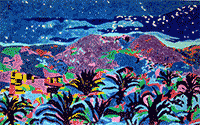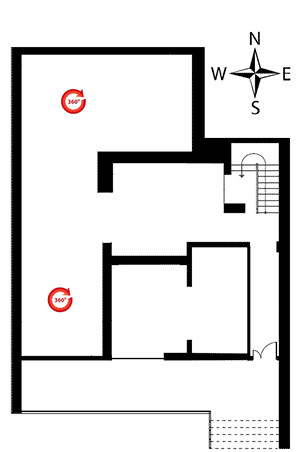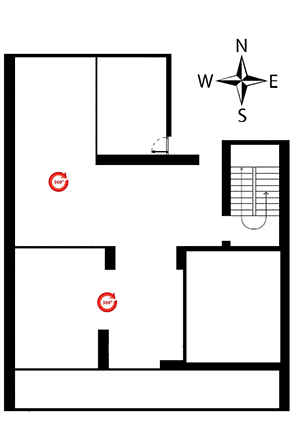You can see the image by
clicking on 360 degree logos.

|
Farshad
Nekoumanesh
Farshad was
born
in
1974
in
Kermanshah
and
graduated
from
Tehran
University
of
Arts
with
a
bachelor's
degree
in
cinema. Bariye is
the
second
solo
exhibition
of Farshad
Nekoomanesh in Shirin
Gallery.
As
the
artist
says
about
this
exhibition:
Dastgah-e
Mahur in
Iranian
traditional
music
is
similar
to a
Major
step
in
classical
music
in
terms
of
distances
and
is
considered
happy
in
terms
of
feeling.
Therefore,
there
are
many
happy
parts
in
this
Dastgah.
Its
roots
attribute
to
the
Maqams
of
ancient
Iranian
music,
especially
the
Maqam
of Oshaq.
The
Maqam
of Bariye between
the
Maqams
of Tanbur and Hoore is
undoubtedly
one
of
the
most
melancholy.
Its
linguistic
origin
is
from
immigration
(the
irony
of
death)
and
is
an
attribute
to Barbad.
The Mahour collection,
part
of
which
exhibited
at
the Zooran Exhibition
in
the
spring
of
2018,
has
now,
in a
two-year
process,
directly
led
to
an
array
of Bariye.
This
new
production
may
derive
from
the
dark
atmosphere
of
these
two
years.
The
German
painter Matthias
Illner says
about
Nekoomanesh's
artworks: "Sometimes
the
silence
of
an
interior
or a
landscape...
I
know
very
little
about Farshad
Nekoomanesh.
He
is a
painter
in
Iran.
His
self-portrait
shows
him
writing
and
sitting
on a
carpet.
But,
to
be
precise,
one
cannot
find
an
actual
facial
expression
that
could
reveal
something
about
his
character
or
feelings.
Farshad's
early
portraits
are
like
dark
menacing
faces
in a
carpet
pattern.
So
when
you
wake
up
from
a
gloomy,
fear-filled
dream,
you
discover
demons
in
your
apartment—threatening
and
ugly
expressions
that
look
at
me,
contrasted
by
pictures
of
lovers
in
nature.
Music-making
men
and
women,
pictures
painted
in
light
colors
and
that
seem
like
a
fairy
tale.
Unreal.
Fairy
tales
in a
painting
style
show
the
pure
colors
and
next
to
each
other
like
a
woodcut.
As
in a
puzzle,
I,
as
the
viewer,
have
to
assemble
the
picture
in
my
head
to
recognize
its
motif.
Different,
if
painted
in
the
same
style,
the
images
of
wrestling
matches
between
men.
Some
landscapes
and
interiors
seem
like
silent
moments
between
the
moving
images.
They
allow
me a
break
from
the
moving
impressions
of
his
figurative."
|
|
|
Samira Alborzkouh
Samira Alborzkouh, born in Tehran in 1985, has MA in painting. She has had many groups and solo exhibitions inside and outside of Iran. Handmade Virus is her third solo exhibition.
As the artist says about this exhibition:” Plastics look like figures in my work, and I look at them like creatures living in the sea. Because they are released into the water and move with the movement, they have a greater sense of being alive, which competes with the living creatures, and their number increases every day.
We live in a time in history that has more viruses in the lives of creatures than ever before, and everything manufactured is unplanned.
From the beginning of working with photographic sources on the Internet, I had the idea to show people by drawing them that how every day the existence of these plastics is for us and how we have exposed the sea, which is the source for the life of the earth, to destruction.
I drew plastic like a living sea creature. And I even ordered a canvas designed like a drop of water to attract more attention to water from different angles. The more I painted, the more I wondered what would happen if the whole sea was covered in plastic, and it made me think of etching with different materials.
But in the end, I will return to painting, but with the plan that plastic will become a wave of the sea and cover it all like clear, shiny, soft, and flexible water if we continue to use plastic in the same way.
|
|
|
|
First
floor

Second
floor

|
|
|